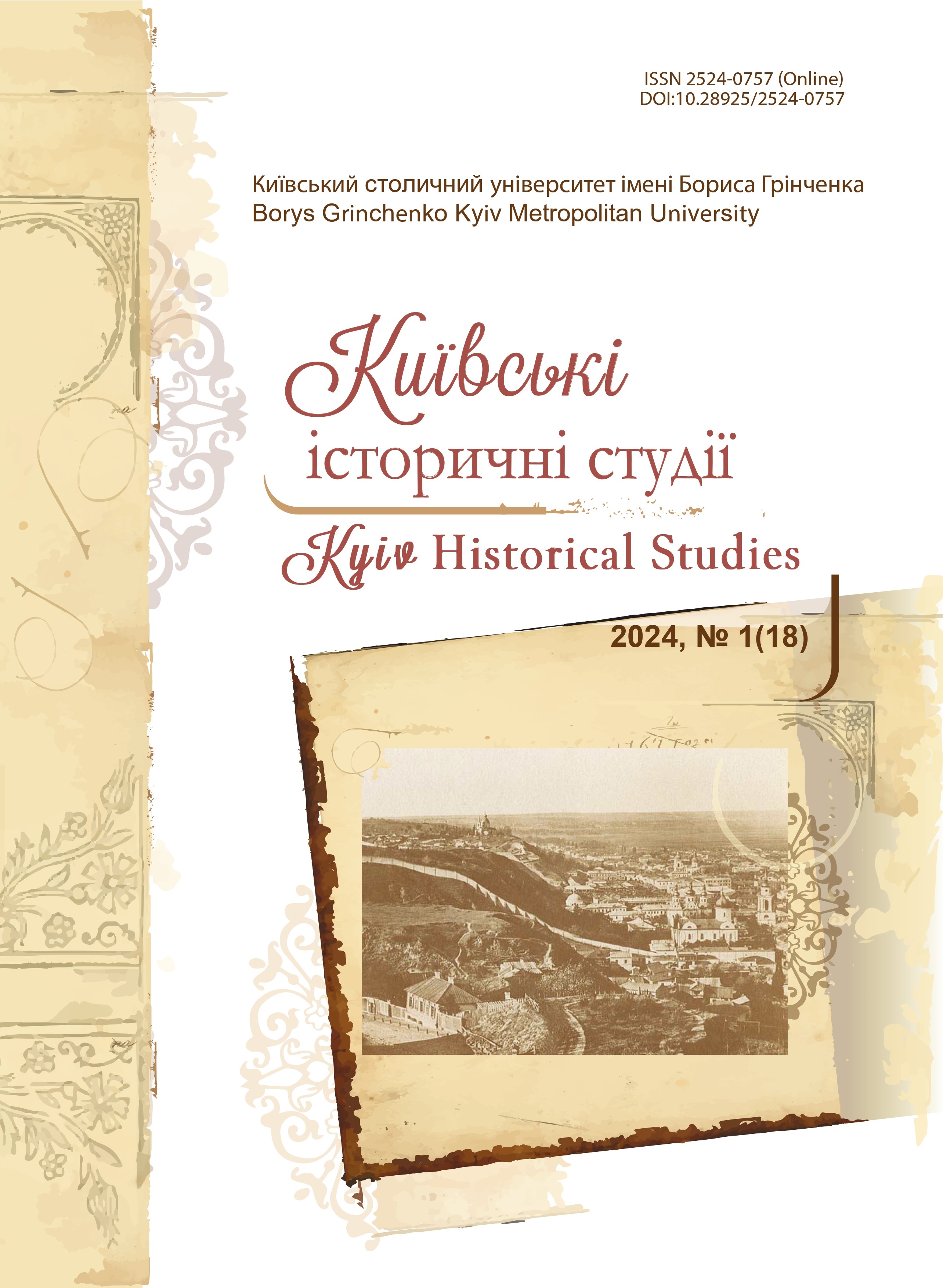Київські мінусники: режимні заборони для «непевних» громадян
DOI:
https://doi.org/10.28925/2524-0757.2024.17Ключові слова:
Київ, столиця УСРР/УРСР, терор, репресії, дискримінація, примусове виселення, мінус, мінусники, ізоляція, режимні територіїАнотація
У статті йдеться про особливу категорію мешканців столиці України, яких було визнано «соціально небезпечними» й покарано висланням з міста сукупно із забороною селитися у низці місцевостей СРСР, а також про категорії городян, на які поширювалася заборона проживати в Києві з інших причини. Вислані за вироком судових, а частіше — позасудових, органів отримували вирок, де заборонені для них території позначалися як «мінус 6», «мінус 12», «мінус 15» (цифри означали кількість визначених місцевостей, а слово «мінус» увійшло в радянську новомову як коренева конструкція поняття «мінусники», що позначало репресовану та дискриміновану в такий спосіб спільноту). Цим та іншим згаданим вище особам у паспорті робився відповідний запис, який унеможливлював перебування в столиці УРСР. Атмосфера режимності у столиці України аналізується як органічний складник функціонування тоталітарного режиму та карально-репресивного механізму, перші оберти якого відбулися одночасно із захопленням влади більшовиками. Простежується поступальне зростання загону київських мінусників, причини набуття ними такого статусу та стратегії виживання в умовах вигнання. Доведено, що в арсеналі тотального терору, окрім найсуворіших репресій, до киян активно застосовувалася й цільова географічна ізоляція, яка стала ефективним засобом «очищення» столиці УРСР від «соціально небезпечних» осіб, механізмом соціальної інженерії пролонгованої дії. Створення великого загону киян-мінусників було складником процесу атомізації суспільства, конструювання просторової ієрархії, соціального відчуження людей і територій.
Завантаження
Посилання
Baiburyn, A. (2017). Sovetskyi pasport: istoriia — struktura — praktiki. St Petersburg: Evropeiskii unyversytet v St Petersburg [in Russian].
Bazhan, O. (2015). Mekhanizm masovikh represii u Kyievi u 1934–1938 rokakh. Abstracts of Papers’15: Vid Ukrainy do URSR: materialy Vseukrainskoi naukovoi konferentsii do 80-richchia perenesennia stolytsi Radianskoi Ukrainy do mista Kyieva (pp. 69–77), Kyiv [in Ukrainian].
Bilokin, S. (2002). Mistse pasportyzatsii v informatsiino-upravlinskii systemi derzhavnoho teroru. In V. Smolii (Ed.), Politychnyi teror i teroryzm v Ukraini XIX–XX stolittia: Istorychni narysy (pp. 515–516). Kyiv: Naukova dumka [in Ukrainian].
Gabor, V. (2018). Pershi periodychni vydannia ukrainskykh panfuturystiv (1922–1924 rr.): vizualni osoblyvosti, mystetske ta ideolohichne spriamuvannia. Zbirnyk prats Naukovo-doslidnoho instytutu presoznavstva, 8, 45–53 [in Ukrainian]. http://nbuv.gov.ua/ UJRN/ZPNDZP_2018_8_4
Gіnzburg, E. S. (1990). Krutoi marshrut: Khronika vremen kulta lichnosti. Moscosw: Sovetskii pisatel [in Russian].
Hagenloh, P. (2009). Stalin’s Police: Public order and mass repression in the USSR, 1926–1941. Baltimore: The John Hopkins University Press [in English].
Kolosov, V. A., & Polyan, P. M. (2009). Ogranichenie territorialnoi mobilnosti i konstruirovanie prostranstva ot stalinskoi epokhi do nashikh dnei. In T. S. Kondrateva, & A. K. Sokolov (Eds.). Rezhimnye liudi (pp. 25–48). Moscow: Rosspen [in Russian].
Krasilnikov, S. (2018). Sotsialnaia mobilizatsiia v stalinskom obshchestve (konets 1920 gg. — 1930 gg.). Moscow: Rosspen [in Russian].
Liber, G. O. (2016). Total Wars and the Making of Modern Ukraine, 1914–1954. Toronto, Buffalo, London: University of Toronto Press [in English].
Mozokhin, O. B. (2006). Pravo na repressii: vnesudebnyie polnomochiia organov gosudarstvennoi bezopasnosti, 1918–1953. Moscow; Zhukovskii: Kuchkovo pole [in Russian].
Muan, N. (2005). Pasportnaia sistema i vybor mesta zhitelstva v Rossii i Sovetskom Soiuze. Neprikosnovennyi zapas, 4, (42) [in Russian]. http://magazines.russ.ru/nz/2005/42/mu9.html
Pastushenko, T. (2011). “Vizd repatriantiv do Kyieva zaboroneno…”: povoienne zhyttia kolyshnikh ostarbaiteriv ta viiskovopolonenykh v Ukraini. Kyiv: Instytut istorii Ukrainy NAN Ukrainy [in Ukrainian].
Pastushenko, Tetiana (2008). Dolia ukrainskykh ostarbaiterok u Nimechchyni ta pislia povernennia do SRSR. Ukraina XX st.: kultura, ideolohiia, polityka, 14, 66–77 [in Ukrainian].
Perepelytsia, I. (1953). Sovietska pasportyzatsiia yak zasib moskovskoho ponevolennia i teroru. Vyzvolnyi shliakh, 11 (73), 17–21 [in Ukrainian].
Pokrovskyi, N. N. (2005–2006). Politbiuro i krestianstvo: vysylka i spetsposelennia 1930–1940, (Vols. 1–2), Moscow: Rosspen [in Russian].
Polyan, P. (2015, 24 avgusta — 6 sentiabria). Geografiia nesvobody: ob infrastrukture deportatsii i sovetskoi rezhimnosti. Demoskop, 651–652 [in Russian]. http://demoscope.ru/weekly/2015/0651/analit04.php
Popov, V. P. (1995). Pasportnaia sistema v SSSR (1932–1976 gg.). Sotsis, 8, 3–14 [in Russian].
Romano, A. (2000). Permanent War Scare: Mobilisation, Militarisation, and the Peasant War. In: Silvio, Pons & Andrea, Romano (eds.). Russia in the Age of Wars, 1914–1945 (pp. 103–121), Milan: Feltrinelli [in English].
Shearer, D. (2018). Stalin at War, 1918–1953. Patterns of Violence and Foreign Threat. Jahrbücher für Geschichte Osteuropas, 66, 2, 188–217 [in English].
Stiazhkina, O. (2021). The Regime of Continuous War: Mobilization, Militarization, and Practices of Maintaining an Undeclared State of Emergency in Soviet Ukraine from the 1920s to 1940s. In Stiazhkina O. Zero Point Ukraine. Four Essays in World War 2. Trans. by S. Kulinska. Ukrainian Voices (pp. 47–94), Shtutgart: Ibidem Verlag [in English].
Vronska, T. (1997). Rezhymno-obmezhuvalni zakhody orhaniv vlady na vyzvolenii terytorii Ukrainy pid chas Velykoi Vitchyznianoi viiny ta v pershi povoienni roky. Storinky voiennoi istorii Ukrainy, 1, 125–142 [in Ukrainian].
Vronska, T., & Stiazhkina, O. (2020). Minusnyky in the Space of the Soviet Terror (1917–1953). Ukrainian Historical Journal, 1, 89–111, 2, 121–141 [in Ukrainian]. https://doi.org/10.15407/uhj2020.01.089
Vronska, T. (1997). Rezhymno-obmezhuvalni zakhody orhaniv vlady na vyzvolenii terytorii Ukrainy pid chas Velykoi Vitchyznianoi viiny ta v pershi povoienni roky. Storinky voiennoi istorii Ukrainy, 1, 125–143. [in Ukrainian].
Vronska, T. (2013). Upokorennia strakhom: simeine zaruchnytstvo u karalnii praktytsi radianskoi vlady (1917–1953 rr.). Kyiv: Tempora [in Ukrainian].
Vronska, T. (2019). Povtornyky: pryrecheni brantsi HULAHu (1948–1953 rr.). Kyiv: Tempora [in Ukrainian].
Vronska, T., & Kulchytskyi, S. (1999). Radianska pasportna systema. Ukrainian Historical Journal, 4, 3–15 [in Ukrainian].
Vronska, T., & Stiazhkina, O. (2021). Minusnyky. Pokarani prostorom. Kyiv: Tempora [in Ukrainian].
Wronśka, T., & Stiażkina, O. (2022). Polacy-„minusowcy” na sowieckiej Ukrainie (lata wudzieste — początek lat trzydziestych. Przegląd Archiwalny Instytutu Pamięci Narodowej, 15, 203–228 [in Polish].
Yampolskii, V. P. (Ed.). (1995). Organy gosudarstvennoi bezopasnosti SSSR v Velikoi Otechestvennoi voine. (Vol. 1), Moscow [in Russian].
Yampolskii, V. P. (Ed.). (2000). Organy gosudarstvennoi bezopasnosti SSSR v Velikoi Otechestvennoi voine. (Vol. 2). Moscow [in Russian].
Zemskov, V. N. (1991). ‘Kulatskaia ssylka v 30-e gody. Sotsiologicheskie issledovaniia, 10, 3–10 [in Russian].
Опубліковано
Як цитувати
Номер
Розділ
Ліцензія
Авторське право (c) 2024 Тамара Вронська

Ця робота ліцензується відповідно до Creative Commons Attribution-NonCommercial-ShareAlike 4.0 International License.
Автори, які публікуються у цьому журналі, залишають за собою право на авторство своєї роботи та передають журналу право першої публікації цієї роботи на умовах публічної ліцензії Creative Commons: Attribution-NonCommercial-ShareAlike 4.0 International (CC BY-NC-SA 4.0), котра дозволяє іншим особам вільно розповсюджувати опубліковану роботу з обов'язковим посиланням на авторів оригінальної роботи та першу публікацію роботи у цьому журналі.














